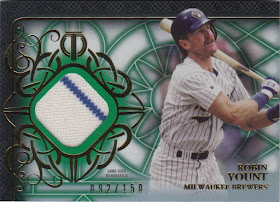Another series of transactions in 1970 for Milwaukee might fall under that same category. Milkes chopped and changed out pitchers and hitters seemingly randomly. The team picked up three pinch-hitters (as noted in the Tito Francona post) around the June 15 trading deadline. At the same time, the team sent Ray Peters down to the minors, sold John O'Donoghue to Montreal and Bob Locker to Oakland, and then signed Brewer #35, Bob Humphreys, as a free agent after the Washington Senators released the 34-year-old.
 |
| 1971 Topps |
Robert William Humphreys was born in Covington, Virginia, on August 18, 1935. Covington is in the middle of the George Washington and Jefferson National Forest along Interstate 64, about 15 miles from the West Virginia State Line and about 45 minutes from Lexington, Virginia (the home of Washington & Lee University). His family migrated southward -- moving closer to Roanoke -- where he graduated high school in Montvale, Virginia. He then attended Hampden-Sydney College -- an all-male military college about an hour away -- and starred in both baseball and basketball.
Humphreys is a smaller guy -- under 6' tall -- so he relied on intelligence and guile as a pitcher. He was never a fireballer, and more than once he was told he had no chance to be a major leaguer. In fact, as his SABR biography begins, he once wrote "YOU CAN'T MAKE IT!" on his glove wristband after being told that by a major-league talent evaluator.
But, he did make it. He signed as an amateur free agent out of college in 1958 with Detroit and got to the major leagues in September of 1962 at the age of 27 years old. The next spring training, his contract was purchased by the St. Louis Cardinals. That was fortuitous for Humphreys, as it meant that he got a World Series Champions ring in 1964 as part of the Cardinal team that overhauled Gene Mauch's collapsing Phillies and then beat the New York Yankees in the World Series.
 |
| 1971 Dell Today's 1971 Milwaukee Brewers |
Most of Humphreys's career was spent as a member of the second incarnation of the Washington Senators. He got there by way of the Chicago Cubs, who obtained the rights to his services thanks to a trade with St. Louis in the spring of 1965. The Sens traded for him in April of 1966 and kept him until Humphreys was released on June 13, 1970.
As his career progressed, he suffered through various arm injuries and ailments. For example, in 1965, he hurt his elbow. Rather than that being the death knell for his career, he changed his pitching to incorporate a slider and cutter taught to him by Tigers teammate Frank Lary. Later in his career, when his shoulder started hurting, he learned a knuckleball from a teammate in the Cardinals minor league system, Bobby Tiefenauer. When he arrived in Milwaukee, manager Dave Bristol told Humphreys to rely on the knuckler.
For most of his career, Humphreys was a reliever. He started just 4 games in his career. Oddly enough, one of those four starts was his final appearance as a major leaguer: Game 2 of a doubleheader between the Brewers and the Chicago White Sox before 3,826 of the White Sox' closest friends at Comiskey Park on September 25, 1970. Humphreys pitched five innings and got the win in that game.
He was released by the Brewers at the end of spring training in 1971 before being signed to a minor league contract. He pitched terribly there -- 7.11 ERA in 19 innings (14 walks, 10 strikeouts) -- and asked for his release as a result. That request was granted and that was the end of his playing career.
 |
| 1994 Miller Commemorative Set |
If you have looked at the three cards I have here, you might be wondering why Humphreys appears to be so old on his 1994 Miller Brewing commemorative set card. That would likely be because of what he did after his career ended. He spent five years as the head coach at Virginia Tech before joining the Toronto Blue Jays for five more years as a minor league instructor.
But then, starting in 1984 and extending all the way through 1995, he was in the Milwaukee Brewers front office. He served through 1994 as coordinator of player development and then two seasons as the coordinator of pitching and field development in 1994 and 1995. As the great St. Louis Cardinals site Retro Simba mentions, Humphreys served as a mentor to long-time Cardinals catcher and current Cardinals manager Mike Matheny while Matheny was coming up with the Brewers.
Humphreys later coached a year at Hampden-Sydney before returning to the minor leagues with the Cardinals. These days and at the age of 81, he is still involved with teaching youngsters baseball, as he is a pitching mentor with Home Run Club Virginia, an organization owned by one of Humphreys' former Hokie players, Orvin Kiser. Another two familiar names to baseball fans are attached to this organization: former Astros pinch-hitter extraordinaire Denny Walling and former big-league pitcher Tom House.
Based on what Trading Card DB has available, I have three of the four Bob Humphreys cards showing him as a Brewer. I am missing the 1971 O-Pee-Chee card of him.
Thanks for stopping by.




























